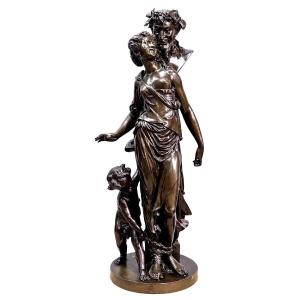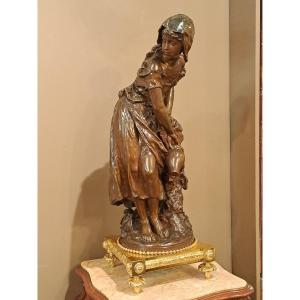Patinated bronze on a beautiful golden base.
Mathurin Moreau, born in Dijon on November 18, 1822 and died in Paris on February 14, 1912, is a French sculptor, renowned for his decorative sculptures.
Mathurin Moreau, who owes his first name to his paternal grandfather, a locksmith in Dijon, was born from the marriage of the sculptor Jean-Baptiste-Louis-Joseph Moreau and Anne Marianne Richer, originally from Besançon where his father, Mathieu Richer, was also a sculptor. . His brothers Hippolyte and Auguste are also sculptors. He was admitted to the Paris School of Fine Arts in 1841 in the workshops of Jules Ramey and Auguste Dumont. He won the second Prix de Rome in 1842 with Diodeme winning the Palladium.
He debuted at the Salon of French Artists in 1848 and stood out there with the statue L'Élégie. He obtained a second class medal at the Universal Exhibition of 1855 in Paris, then a first class medal in 1878. In 1897, he was crowned with a medal of honor at the Salon of which he became a member of the jury during the Exhibition. universal of 1900 in Paris.
Between 1849 and 1879, Mathurin Moreau collaborated with the Val d'Osne art foundry and, as a shareholder, became one of its directors, but, observes Pierre Kjellberg, "the reign of Napoleon III was also that of fireplace trims , and these hitherto very rare sets are multiplying and often appear in the catalogs of bronze publishers”: Mathurin Moreau's Reader is part of this craze. The artist also provided models to the Compagnie des bronzes de Bruxelles and exhibited at the Central Union of Fine Arts Applied to Industry in the 1880s.
From 1879 and until his death, Mathurin Moreau was elected mayor of the 19th arrondissement of Paris. He was named knight of the Legion of Honor in 1865 and promoted to officer of the same order in 1885.
He died on February 14, 1912.






























 Le Magazine de PROANTIC
Le Magazine de PROANTIC TRÉSORS Magazine
TRÉSORS Magazine Rivista Artiquariato
Rivista Artiquariato
